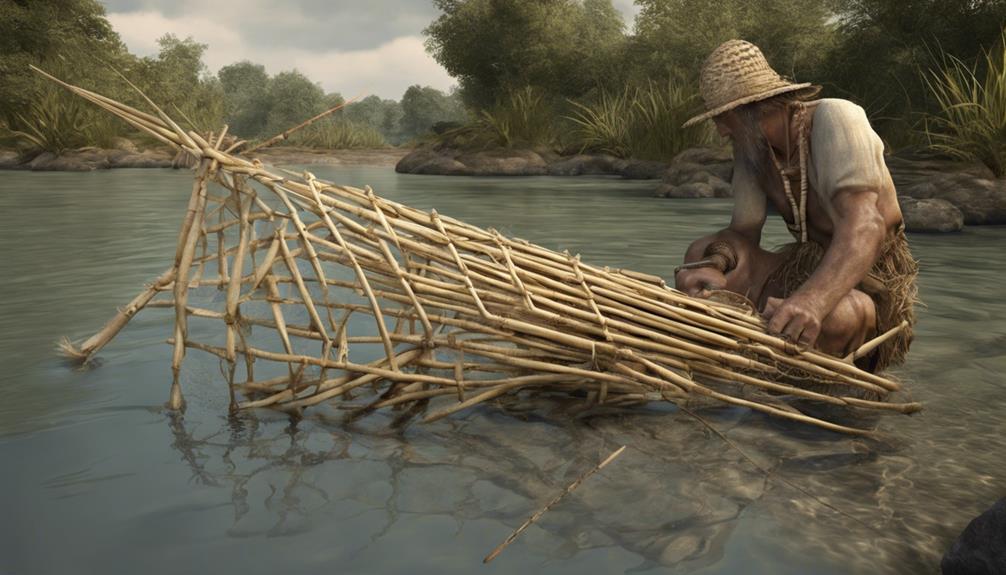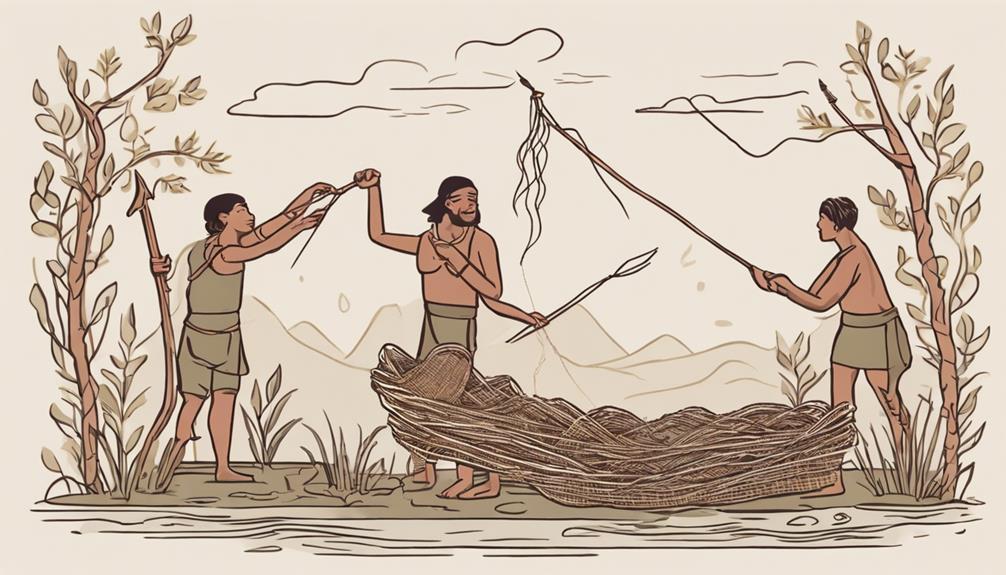Discover three prehistoric techniques for successful angling. Master the art of spearfishing, where skill, precision, and breath control were key. Dive deep into trap and weir fishing, utilizing water management to direct fish into enclosures for effortless catches. Explore the ancient method of handline fishing, a reliable source of sustenance that was deeply woven into cultural and social practices. These techniques were vital for early civilizations' survival and continue to offer insights into sustainable angling practices today. Uncover the secrets of our ancestors' fishing strategies for a richer understanding of successful angling in prehistoric times.
Early Humans and Fishing
During prehistoric times, early humans utilized various fishing techniques to secure food sources and sustain their communities. Fishing adaptations were crucial for the survival of early civilizations. One of the key fishing adaptations during this period was the use of nets. Nets allowed early humans to catch larger quantities of fish compared to individual hand-catching methods. This innovation significantly increased their ability to procure food efficiently, especially in areas with abundant fish populations.
Furthermore, early humans developed tools such as fish hooks made from bones or shells. These fishing tools were essential for catching fish in rivers, lakes, and even coastal areas. The use of fish hooks marked a significant advancement in fishing technology, enabling early humans to target specific fish species and improve their overall catch rates.
In addition to nets and fish hooks, early civilizations also employed fishing traps. These traps were strategically placed in bodies of water to capture fish as they swam by. By utilizing fishing traps, early humans could passively collect fish while focusing on other essential tasks within their communities.
Spearfishing in Ancient Waters
Utilizing sharpened wooden or bone-tipped spears, ancient civilizations honed the art of spearfishing in their quest for sustenance from the abundant waters that surrounded them. Spearfishing was a crucial technique in ancient fishing practices, allowing early humans to efficiently catch fish for food. This method required skill, precision, and an understanding of aquatic habitats.
Ancient spearfishers often positioned themselves strategically near shallow waters, where fish congregated. By observing the movement patterns of fish, they could anticipate the best moment to strike with their spears. The use of sharpened tips made from durable materials like bone or wood ensured successful penetration and capture of fish.
Spearfishing techniques varied among different ancient civilizations. Some cultures developed specialized spears with barbs or multiple points to increase the chances of catching fish. Additionally, the development of throwing techniques allowed spearfishers to target fish swimming at greater depths or speeds.
Successful spearfishing also relied on the ability to hold one's breath underwater for extended periods. Ancient fishers often practiced breath control and diving techniques to enhance their effectiveness in capturing fish. These skills were passed down through generations, contributing to the sustainability of ancient fishing practices and the survival of early human societies.
Trap and Weir Fishing Methods
Trap and weir fishing methods have been integral to the history of angling, providing ancient civilizations with innovative ways to capture fish for sustenance. Water management played a crucial role in the success of these techniques. By strategically placing traps and weirs in rivers or along coastlines, early anglers could control the flow of water to direct fish into their nets or enclosures. This method allowed them to exploit the natural behavior of fish, leading them towards the traps for an easier catch.
Resource abundance was another key factor in the effectiveness of trap and weir fishing methods. Ancient societies often relied on these techniques in areas where fish populations were plentiful. By constructing traps and weirs in locations teeming with fish, anglers could maximize their catch with minimal effort. This not only provided food for immediate consumption but also allowed for preservation through drying or smoking, ensuring a stable food supply during times of scarcity.
Handline Fishing Techniques
Handline fishing techniques involve the use of a single fishing line with a hook attached, allowing anglers to target specific fish species with precision and control. Ancient handline techniques were crucial for early humans, providing them with a reliable method to catch fish for sustenance. These survival skills were honed over generations, with prehistoric fishing methods evolving to become more efficient and refined.
In prehistoric times, handline fishing played a significant role in the daily lives of communities, showcasing its cultural significance. It wasn't just a means of acquiring food but also a social activity that brought people together. The knowledge of how to craft fishing lines, select suitable hooks, and understand the behavior of different fish species was passed down from one generation to the next, emphasizing the importance of these skills in ancient societies.
When engaging in handline fishing, it's essential to consider various factors such as the depth of the water, the type of bait used, and the movement of the fish. By mastering these techniques, ancient anglers were able to secure a consistent food source, demonstrating their resourcefulness and adaptability in challenging environments. As you practice handline fishing today, remember that you're carrying on a tradition that dates back centuries, reflecting the ingenuity and perseverance of our ancestors.
Prehistoric Net Fishing Innovations
As ancient communities honed their fishing skills through handline techniques, they also developed innovative methods of net fishing that revolutionized their approach to catching fish for sustenance. Net weaving played a crucial role in prehistoric net fishing innovations. These nets were meticulously crafted using materials such as plant fibers or animal sinew, skillfully woven together to create effective fishing tools. The intricate designs of these nets allowed for the capture of a larger quantity of fish compared to handline fishing, making them a significant advancement in prehistoric angling techniques.
Moreover, watercraft construction was another key aspect of prehistoric net fishing innovations. Early societies realized that using boats or rafts could greatly enhance their fishing capabilities. By combining net weaving with the construction of watercraft, they were able to venture into deeper waters and strategically position their nets to maximize their catch. The integration of net fishing with watercraft not only increased the efficiency of fishing expeditions but also enabled communities to target a wider variety of fish species.
The Role of Bait in Antiquity
The utilization of various natural and artificial baits played a significant role in the fishing practices of ancient civilizations, enhancing their ability to attract and catch fish for sustenance. Bait selection in antiquity was a crucial aspect of successful fishing expeditions, with different cultures developing unique techniques to optimize their catches.
- Natural Baits: Ancient fishermen often used live bait such as insects, worms, or small fish to entice larger catches. These natural baits were readily available and mimicked the prey of the target fish, increasing the chances of a successful catch.
- Artificial Baits: Some ancient civilizations crafted artificial baits from materials like feathers, fur, or plant fibers. These lures were designed to replicate the movement and appearance of prey, effectively attracting fish to the hook.
- Preservation Methods: In order to ensure a steady supply of bait, ancient fishermen developed techniques to preserve natural baits. Drying, salting, or fermenting were common methods used to store bait for extended periods without spoilage.
- Cultural Significance: The art of bait making and selection was often passed down through generations, becoming integral to the cultural heritage of many ancient societies. Fishing bait held historical significance, symbolizing the connection between humans and the natural world.
Understanding the importance of bait selection and the historical significance of fishing bait provides valuable insights into the fishing practices of ancient civilizations.
Primitive Fishing Tools and Gear

Utilizing rudimentary tools and basic gear, ancient fishermen devised innovative methods to navigate the waters and secure their catches, showcasing early ingenuity in primitive fishing practices. In the Stone Age, hooks were crafted from materials like bone, wood, or even thorns. These early fishing hooks were simple in design but effective in catching fish. Fishermen would attach these hooks to lines made from plant fibers or animal sinew, allowing them to lure and hook fish with precision.
Ancient fish traps were another essential tool in early fishing. These traps varied in complexity, ranging from woven baskets submerged in water to stone structures that directed fish into contained areas. Fishermen strategically placed these traps in rivers or along the coast, taking advantage of the natural behavior of fish to lead them into the traps. Once the fish were caught inside, fishermen could easily retrieve their haul.
These primitive fishing tools and gear highlight the resourcefulness and problem-solving skills of ancient anglers. The Stone Age hooks and ancient fish traps demonstrate how early humans adapted to their environments to fulfill their basic needs like food procurement. By understanding and utilizing these tools, ancient fishermen were able to sustain themselves and their communities through successful fishing practices.
Evolution of Prehistoric Angling
Exploring the progression of ancient fishing methods unveils a fascinating narrative of technological advancement and strategic innovation in prehistoric angling practices. In the evolution of prehistoric angling, Paleolithic fishing strategies laid the groundwork for more sophisticated Neolithic fishing techniques.
- Paleolithic Fishing Strategies
- Utilized simple tools like sharpened sticks or bone hooks.
- Relied on hand-crafted nets made from plant fibers.
- Employed basic knowledge of fish behavior and habitat.
- Demonstrated early human ingenuity in catching aquatic prey.
- Neolithic Fishing Techniques
- Introduced more advanced tools such as harpoons and fish traps.
- Developed methods for creating durable fishing lines from natural materials.
- Innovated in boat construction, enabling offshore fishing.
- Showed a deeper understanding of fish migration patterns and seasonal variations.
The transition from Paleolithic fishing strategies to Neolithic fishing techniques marked a significant shift towards more efficient and sustainable methods of angling. This evolution wasn't just about survival but also about enhancing productivity and resource management in prehistoric societies. The adaptability and progression seen in these ancient fishing practices reflect the continual development of human knowledge and skills over time, paving the way for the diverse angling techniques we have today.
Frequently Asked Questions
How Did Early Humans Preserve Their Catch Before Refrigeration?
Before refrigeration, early humans used traditional methods for food preservation.
One common technique involved smoking the catch over a fire to dehydrate and preserve it. This method not only extended the shelf life of the fish but also added flavor.
Another method was salting the fish, which drew out moisture and inhibited bacterial growth. These techniques were essential for ensuring a stable food supply and minimizing waste in prehistoric times.
What Were the Common Dangers Faced by Ancient Spearfishers?
When ancient spearfishers ventured into the waters, they faced various dangers. From aggressive sea creatures to treacherous underwater currents, survival was no easy feat.
To combat these perils, early fishermen developed ingenious techniques. They honed their spearfishing skills to swiftly catch prey while remaining vigilant against potential threats.
How Did Prehistoric Fishermen Navigate and Locate Fishing Grounds?
To locate fishing grounds, prehistoric fishermen utilized knowledge of underwater topography and celestial navigation. Studying the layout of the seabed helped them understand where fish congregated.
Were There Specific Rituals or Ceremonies Associated With Prehistoric Fishing?
Specific rituals and ceremonies were integral to prehistoric fishing practices. Ritual significance and ceremonial practices were deeply intertwined with cultural traditions and spiritual beliefs.
These ceremonies often involved offerings to appease spirits of the water and ensure a bountiful catch. By honoring these traditions, prehistoric fishermen believed they could attract fish and guarantee successful angling expeditions.
The connection between rituals and fishing reflected the importance of spirituality in their daily lives.
Did Ancient Fishermen Have Any Superstitions Related to Successful Angling?
Ancient fishermen indeed had superstitions related to successful angling. These beliefs often revolved around appeasing spirits of the water or invoking luck from higher powers.
Conclusion
You have now explored three prehistoric techniques for successful angling used by early humans:
- Spearfishing
- Trap and weir fishing
- Handline fishing
These methods showcase the ingenuity and resourcefulness of our ancestors in their quest for sustenance from ancient waters.
By understanding and appreciating these primitive fishing techniques, we gain insight into the evolution of angling practices and the pivotal role fishing played in the survival and development of early human societies.



